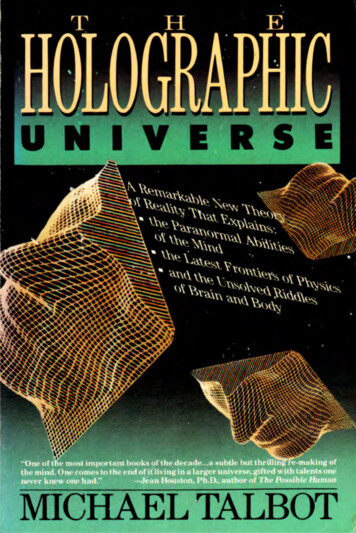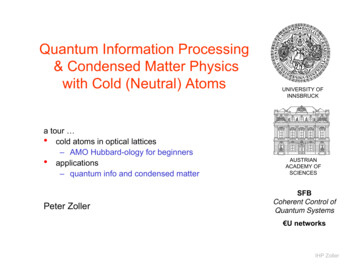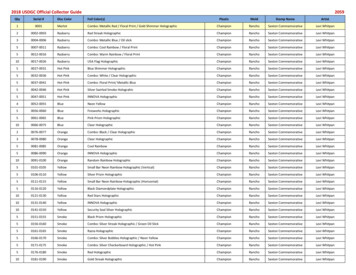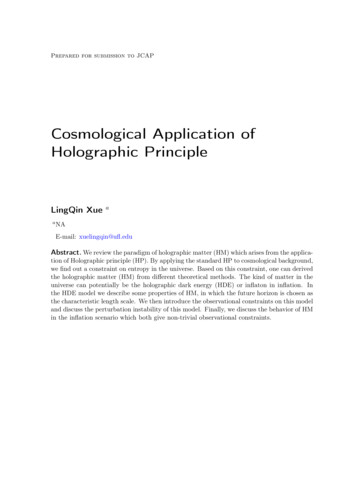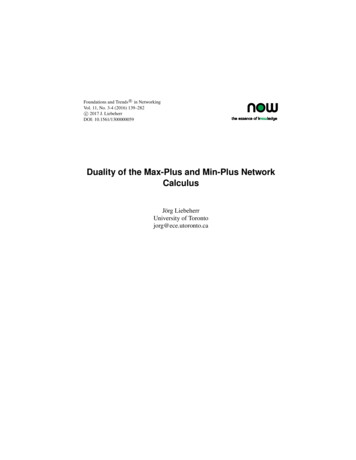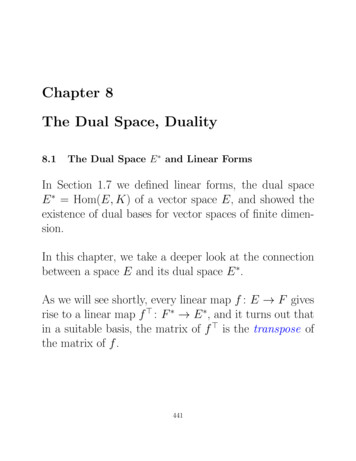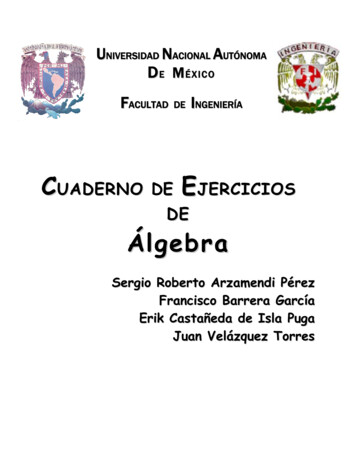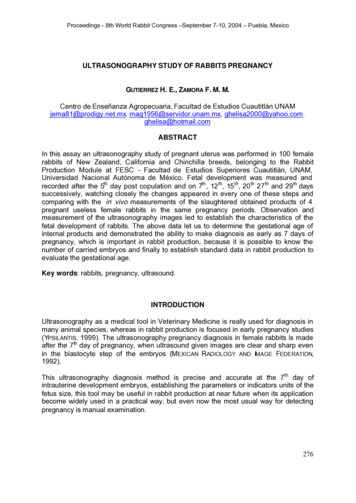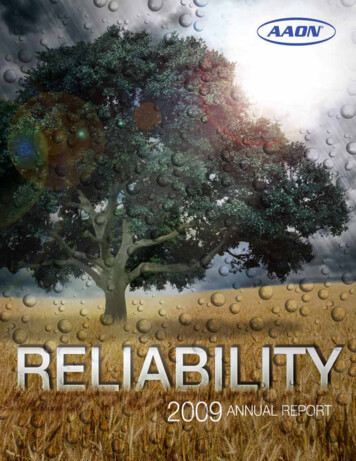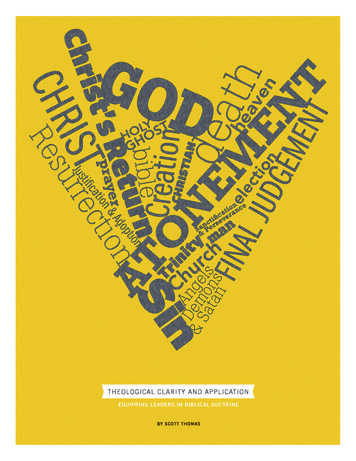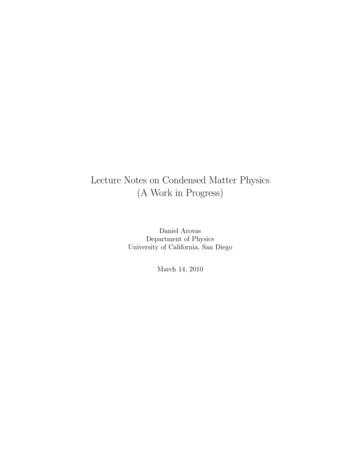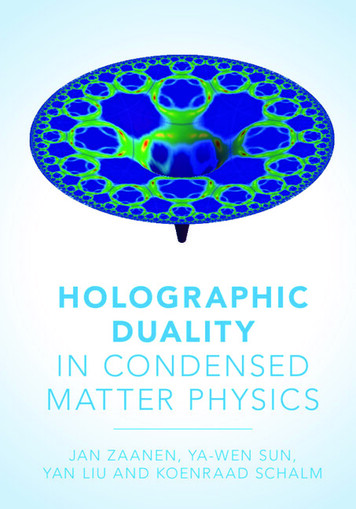
Transcription
H O L O G R A P H I C D UA L I T Y I N C O N D E N S E DM AT T E R P H Y S I C SThis pioneering treatise presents how the new mathematical techniques of holographicduality unify seemingly unrelated fields of physics. Morphing quantum field theory, general relativity and the renormalisation group into a single computational framework, thisbook is the first to bring together a wide range of research in this rapidly developing field.Set within the context of condensed matter physics and using boxes highlighting the specific techniques required, it examines the holographic description of thermal properties ofmatter, Fermi liquids and superconductors, and hitherto unknown forms of macroscopicallyentangled quantum matter in terms of general relativity, stars and black holes.Showing that holographic duality can succeed where classic mathematical approachesfail, this text provides a thorough overview of this major breakthrough at the heart of modern physics. The inclusion of extensive introductory material using non-technical languageand online Mathematica notebooks ensures the appeal to students and researchers alike.J A N Z A A N E N is Professor of Theoretical Physics at the Instituut-Lorentz for TheoreticalPhysics, Leiden University, the Netherlands where he specialises in the physics of stronglyinteracting electrons. He is a recipient of the Dutch Spinoza Award and fellow of the DutchRoyal Academy of Sciences and the American Physical Society.Y A - W E N S U N is a Postdoctoral Researcher at the Institute for Theoretical Physics atthe Universidad Autónoma de Madrid where she works on applications of AdS/CFT tocondensed matter theory, QCD and hydrodynamics as well as other aspects of quantumgravity.Y A N L I U is a Postdoctoral Researcher at the Institute for Theoretical Physics at the Universidad Autónoma de Madrid where he specialises in high-energy theoretical physicsincluding gauge/gravity duality and AdS/CMT.K O E N R A A D S C H A L M is Professor of Theoretical Physics at the Instituut-Lorentz forTheoretical Physics, Leiden University, the Netherlands. His research focusses on howstring theory may be detected in laboratory experiments or cosmological observations. Heis the recipient of Innovative Research Incentives Awards of the Netherlands Organisationfor Scientific Research.Downloaded from Cambridge Books Online by IP 150.244.109.12 on Sat Nov 21 06:13:28 GMT 2015.http://ebooks.cambridge.org/ebook.jsf?bid CBO9781139942492Cambridge Books Online Cambridge University Press, 2015
Downloaded from Cambridge Books Online by IP 150.244.109.12 on Sat Nov 21 06:13:28 GMT 2015.http://ebooks.cambridge.org/ebook.jsf?bid CBO9781139942492Cambridge Books Online Cambridge University Press, 2015
H O L O G R A P H I C D UA L I T Y I NC O N D E N S E D M AT T E R P H Y S I C SJA N Z A A N E NUniversiteit Leiden, the NetherlandsYA - W E N S U NUniversidad Autónoma de Madrid, SpainYA N L I UUniversidad Autónoma de Madrid, SpainKO E N R A A D S C H A L MUniversiteit Leiden, the NetherlandsDownloaded from Cambridge Books Online by IP 150.244.109.12 on Sat Nov 21 06:13:28 GMT 2015.http://ebooks.cambridge.org/ebook.jsf?bid CBO9781139942492Cambridge Books Online Cambridge University Press, 2015
University Printing House, Cambridge CB2 8BS, United KingdomCambridge University Press is part of the University of Cambridge.It furthers the University’s mission by disseminating knowledge in the pursuit ofeducation, learning and research at the highest international levels of excellence.www.cambridge.orgInformation on this title: www.cambridge.org/9781107080089c Cambridge University Press 2015 This publication is in copyright. Subject to statutory exceptionand to the provisions of relevant collective licensing agreements,no reproduction of any part may take place without the writtenpermission of Cambridge University Press.First published 2015Printed in the United Kingdom by TJ International Ltd. Padstow CornwallA catalogue record for this publication is available from the British LibraryLibrary of Congress Cataloguing in Publication dataZaanen, Jan, 1957– author.Holographic duality in condensed matter physics / Jan Zaanen (Universiteit Leiden,the Netherlands), Yan Liu (Universidad Autónoma de Madrid, Spain), Ya-Wen Sun(Universidad Autónoma de Madrid, Spain), Koenraad Schalm(Universiteit Leiden, the Netherlands).pages cmIncludes bibliographical references and index.ISBN 978-1-107-08008-9 (hbk.)1. Condensed matter. 2. Holography. I. Liu, Yan (Postdoctoral researcher),author. II. Sun, Ya-Wen, author. III. Schalm, Koenraad, 1971– author. IV. Title.QC173.457.H65Z36 2015530.4 12–dc232015021137ISBN 978-1-107-08008-9 HardbackAdditional resources for this publication at www.cambridge.org/9781107080089Cambridge University Press has no responsibility for the persistence or accuracyof URLs for external or third-party internet websites referred to in this publication,and does not guarantee that any content on such websites is, or will remain,accurate or appropriate.Downloaded from Cambridge Books Online by IP 150.244.109.12 on Sat Nov 21 06:13:28 GMT 2015.http://ebooks.cambridge.org/ebook.jsf?bid CBO9781139942492Cambridge Books Online Cambridge University Press, 2015
ContentsPrefacepage ix1Introduction11.1A tour guide of holographic matter11.2The AdS/CFT correspondence: unifying the theories of physics31.3AdS/CFT, the geometrisation of the renormalisation groupand the quantum critical state61.4Holographic duality and the nature of matter181.5Holography, condensed matter physics and quantum information 272Condensed matter: the charted territory2.1Quantum field theory in condensed matter: the fluctuatingorder of bosons2.2Quantum matter: when entanglement becomes macroscopic2.3The remarkable Fermi liquid2.4The mean-field instabilities of the fermion system: BCS andbeyond2.5The Hertz–Millis model and the critical Fermi surface32Condensed matter: the challenges3.1The repertoire of strongly correlated electron models3.2Mottness, non-Fermi liquids and RVB superconductivity3.3Unconventional superconductivity by weak repulsiveinteractions3.4Numerical machinery I: the density-matrix renormalisationgroup and tensor-product states3.5Numerical machinery II: infinitely many dimensions and thedynamical mean-field theory3.6Quantum matter in the laboratory7376793345157646988909294vDownloaded from Cambridge Books Online by IP 150.244.109.12 on Sat Nov 21 06:13:53 GMT 2015.http://ebooks.cambridge.org/ebook.jsf?bid CBO9781139942492Cambridge Books Online Cambridge University Press, 2015
vi45678ContentsLarge-N field theories for holography and condensed matter4.1A short history of the holographic principle, black holes,string theory and the origins of the AdS/CFT correspondence4.2Yang–Mills as a matrix field theory and the ultimate meanfield at large-N4.3The master formulation of large-N matrix models and stringtheory4.4The AdS/CFT correspondence is a field-theory/gravitydualityThe AdS/CFT correspondence as computational device: thedictionary5.1The GKPW rule in action: computing correlation functions5.2Correlations, scaling and RG flows5.3The identification of symmetries and the dictionary tableFinite-temperature magic: black holes and holographicthermodynamics6.1Black holes in the bulk and finite temperature in theboundary6.2Holographic thermodynamics: the Hawking–Pagetransition6.3A brief introduction to AdS/QCD6.4The GKPW rule at finite temperature: thermal correlationfunctions and the Schwinger–Keldysh formalismHolographic hydrodynamics7.1Quantum criticality and the minimal viscosity7.2Deriving the Navier–Stokes fluid from the bulk dynamicalgravity7.3The conductivity: conserved currents as photons in the bulk7.4Hydrodynamics and quantum anomaliesFinite density: the Reissner–Nordström black hole and strangemetals8.1The Reissner–Nordström strange metal8.2The AdS2 near-horizon geometry and the emergent localquantum criticality8.3The zero sound and conductivity of the RN metal in theGalilean continuum8.4The scaling atlas of emergent holographic quantum criticalphasesDownloaded from Cambridge Books Online by IP 150.244.109.12 on Sat Nov 21 06:13:53 GMT 2015.http://ebooks.cambridge.org/ebook.jsf?bid CBO9781139942492Cambridge Books Online Cambridge University Press, 26238243253259261267271281
Contents9Holographic photoemission and the RN metal: the fermions asprobes9.1The holographic encoding of fermions9.2The discovery of the holographic Fermi surfaces9.3Computing fermion spectral functions: Schrödingerpotentials and the matching method9.4The physics of the holographic fermions: confinement,semi-holography and black-hole stability10 Holographic superconductivity10.1 The black hole in AdS with scalar hair10.2 The phenomenology of holographic superconductivity10.3 Observing the origin of Tc : the pair susceptibility of thestrange metal10.4 The phase diagram of holographic superconductivity10.5 The zero-temperature states of holographic superconductors11 Holographic Fermi liquids: the stable Fermi liquid and theelectron star as holographic dual11.1 The cohesive Landau Fermi liquid from hard-wall holography11.2 The electron star as the dual of holographic fermions11.3 The landscape of holographic Fermi liquids: radialre-quantisation and 7738139040312 Breaking translational invariance12.1 Transport and un-particle physics: the memory-matrixformalism12.2 Periodic potentials in holographic superconductors and theoptical conductivity12.3 Lattice potentials and the fermion spectral functionsof the Reissner–Nordström metal12.4 Unidirectional potentials becoming strong: Bianchi VIIgeometry and the quantum smectic12.5 The dual of translational-symmetry breaking as gravity witha mass12.6 Holographic crystallisation: the spontaneous breakingof translational symmetry41713 AdS/CMT from the top down13.1 Top-down AdS/CMT models from supergravity13.2 Probe-brane holography from D p/Dq-brane intersections470472483Downloaded from Cambridge Books Online by IP 150.244.109.12 on Sat Nov 21 06:13:53 GMT 2015.http://ebooks.cambridge.org/ebook.jsf?bid CBO9781139942492Cambridge Books Online Cambridge University Press, 2015420432437442452463
viiiContents14 Outlook: holography and quantum matter14.1 The UHOs: the unidentified holographic objects14.2 Is holographic matter extreme quantum matter?14.3 The final message for condensed matterReferencesIndex504505511540543570Downloaded from Cambridge Books Online by IP 150.244.109.12 on Sat Nov 21 06:13:53 GMT 2015.http://ebooks.cambridge.org/ebook.jsf?bid CBO9781139942492Cambridge Books Online Cambridge University Press, 2015
PrefaceNot so long ago, two large and quite old fields in physics, string theory and condensed matter physics, were more or less at the opposite ends of the physicsbuilding. During the 40 or so years of its history, string theory has developed intoa high art of “mathematical machine building”, propelled forwards by the internalpowers of mathematics as inspired by physics. Yet, it has suffered greatly for theshortcoming that its theoretical answers are always beyond the reach of experimental machinery. Modern condensed matter physics is in the opposite corner. Ithas been propelled forwards by continuously improving experiments, which havedelivered one serendipitous discovery after another during the last few decades.However, its interpretational framework rests by and large on equations developed 40 years or so ago. There has been an increasing sense that it is these thatfall short in trying to explain the strongly interacting quantum many-body systems as realised by electrons in high-T c superconductors and other unconventionalmaterials.All this changed dramatically in 2007 when physicists started to feed condensedmatter questions to the most powerful mathematical machine of string theory:the holographic duality in the title of the book, also known as the “anti-de Sitter/conformal field theory” (AdS/CFT) correspondence. This book introduces theexplosion of answers that has followed since then.The first (Jan) and last (Koenraad) of this book’s authors are from such opposite corners. As soon as the seminal work of Herzog, Kovtun, Sachdev and Sonin 2007 showed that these two subjects have dealings with each other, Jan andKoenraad recognised the potential and met up, almost literally half-way up thestairs. As has been characteristic for the development at large, it took us remarkably little effort to get on speaking terms, despite our superficially very differentbackgrounds. Shrouded by differences in language, string theory and condensedmatter had already been on a collision course for a while, meeting each other onthe common ground of quantum criticality/conformal field theory. In the years thatixDownloaded from Cambridge Books Online by IP 150.244.109.12 on Sat Nov 21 06:14:03 GMT 1Cambridge Books Online Cambridge University Press, 2015
xPrefacefollowed this dialogue only intensified and the upbeat tone of this book is a testimony of the great time we had together. The largest part of that time was sharedwith the two middle authors (Ya-Wen and Yan), who came to Leiden as postdocsin 2010, freshly graduated from the Chinese Academy of Science in Beijing. Theseeds for this book were planted when Jan received the invitation to become the2012 Solvay Professor in Brussels, with the request to organise an AdS/condensedmatter-theory lecture course. What you see before you grew from the notes of thiscourse, joined together with lecture notes by Koenraad at the 2012 Cargèse and2013 Crete schools.This is an incredibly fast-moving field, and many pages had to be added todescribe the developments that happened since the summer of 2012. In January2014 we stopped playing catch up, and we decided to get it out as quickly as possible, given the high demand for such a text at this moment. The first nine months of2014 turned into a writing frenzy for all of us, and the result is lying in front of you.We are well aware that in certain regards the book therefore has its limitations andthat the text will already be obsolete as soon as it appears. Examples of significantdevelopments that occurred since our cut-off are a holographically inspired theory of incoherent metals1 and a holographic solution of the anomalous temperaturescaling of the Hall angle as observed in high-Tc superconductors.2 Nor do we claimthis to be a comprehensive review that does justice to all of the papers which havebeen published on the subject. What we have done is to provide an introduction toserve a non-expert readership that wishes to be informed about the main developments. Our aim has been to catch the mainstream, those developments where onediscerns a consensus in the expert community that these are the most significantaccomplishments. As authors we found it quite obvious how to make this selection and we sincerely believe that our choices will be approved by the AdS/CMTexperts. We felt that we just had the role of humble narrators working on the chronicles of a monumental physics odyssey. We wish to take you on board and we hopeyou will enjoy it as much as we do!We are in the first instance indebted to numerous holographists who contributedto our understanding of the correspondence. We are particularly grateful to AndreaAmoretti, Steffen Klug, Richard Davison, Andrey Bagrov, Petter Sæterskog andBalázs Meszéna for their thorough proofreading of the manuscripts and their manyhelpful suggestions, and to Mihael Petač for his help on the figures. Both the Leidenand Madrid physics departments gave us all the room to concentrate on the writingof this book. We acknowledge financial support of various funding organisations,in particular the Solvay Foundation and the Dutch Foundation of Fundamental1 S. Hartnoll, Nature Phys. 11, 54 (2015), arXiv:1405.3651.2 M. Blake, A. Donos, Phys. Rev. Lett. 114, 021601 (2015), arXiv:1406.1659.Downloaded from Cambridge Books Online by IP 150.244.109.12 on Sat Nov 21 06:14:03 GMT 1Cambridge Books Online Cambridge University Press, 2015
PrefacexiResearch on Matter (FOM) in the initial stages of this project, as well as the Spanish MINECO’s “Centros de Excelencia Severo Ochoa” Programme under grantSEV-2012-0249, the Netherlands Organisation for Scientific Research/Ministry ofScience and Education (NWO/OCW), and a grant from the Templeton Foundation: the opinions expressed in this publication are those of the authors and do notnecessarily reflect the views of the John Templeton Foundation. Jan Zaanen andKoenraad Schalm acknowledge the hospitality of various institutions during thewriting process: the Aspen Center of Physics, supported by the National ScienceFoundation under Grant No. PHYS-1066293, the Kavli Institute for TheoreticalPhysics, supported by the National Science Foundation under Grant No. NSFPHY11-25915, and the physics department of Harvard University in particular.Jan Zaanen, Ya-Wen Sun, Yan Liu and Koenraad SchalmLeiden and MadridDownloaded from Cambridge Books Online by IP 150.244.109.12 on Sat Nov 21 06:14:03 GMT 1Cambridge Books Online Cambridge University Press, 2015
Downloaded from Cambridge Books Online by IP 150.244.109.12 on Sat Nov 21 06:14:03 GMT 1Cambridge Books Online Cambridge University Press, 2015
1Introduction1.1 A tour guide of holographic matterA quake is rumbling through the core of physics. Suddenly apparently unrelatedareas appear to have a common ground, showing an eerie capacity to fertiliseeach other. In physics such occasions are invariably propelled by novel mathematical machinery and the present case is no exception. This new mathematicalcontraption is “holographic duality” (or “anti-de Sitter/conformal field theory correspondence”), which was originally discovered in string theory in the 1990s. Untilrecently its use was limited to the historic scope of string theory – particle physicsand quantum gravity. At a breathtaking pace it has since rolled out over many ofthe subject areas of modern fundamental physics, even yielding new insights intoold subjects such as the nineteenth-century theory of hydrodynamics.Several books of this kind could be written, and are being written, highlightinghow anti-de Sitter/conformal field theory (AdS/CFT) impacts on various fields inphysics. This book will focus on a prominent area where the developments havebeen particularly stunning. This is the application to equilibrium condensed matter physics. This started in 2007, and in a matter of a few years condensed mattertheory was rewritten in a different mathematical language. This language is theone that one would perhaps least expect: general relativity. On its own a rewriting of condensed matter might not sound like a great advance, no matter howunconventional the language. However, the correspondence makes it possible toexplore regimes of quantum many-body physics that are completely inaccessiblewith conventional techniques. In particular we refer to non-Fermi-liquid states ofmatter formed in finite-density systems of strongly interacting fermion systems.The holographic mathematics here becomes particularly expressive, suggestingthat a general principle of a new kind is at work. It appears that this principle relatesto the physics of compressible quantum matter: the notion that the nature of thisstate of matter is governed by a macroscopic quantum entanglement involving all1Downloaded from Cambridge Books Online by IP 150.244.109.12 on Sat Nov 21 06:14:12 GMT 2Cambridge Books Online Cambridge University Press, 2015
2Introductionof its constituents. This discovery is not just remarkable on its own. “Holographicstrange matter” also has tantalisingly suggestive resemblances to the mysteriousphenomena observed experimentally in strongly interacting electron systems thathave been realised in special materials such as the high-Tc superconductors. Firstseen around thirty years ago, these have defied any reasonable explanation despitecountless attempts resting on the available mathematical techniques. Could it bethat holography supplies the mathematical equations that will shine light on thisnumber-one mystery of condensed matter physics?The correspondence also has its limitations. Though much evidence has beencollected in favour, the jury is still out both with regard to the quantum information aspects and regarding the empirical relevancy. At present holography is anexciting research programme with a potential to alter the fundaments of the theory of physics. This should be of interest to the physics community at large, butthere is an intrinsic difficulty. String theory famously has to be a unified theory ofphysics, but by the discovery of AdS/CFT this was changed into the “unificationof the theories of physics”. The implication is that the physicist has to pay theprice that he/she has to be expert in all fanciful, modern areas of physics at thesame time! A head-on encounter with the application of holography often entails anearly seamless switch between string theory and high-energy-style quantum fieldtheory, sophisticated general relativity including the latest in black-hole physics,via modern condensed matter theory, all the way to the tedious data sorting thatone encounters in dealing with the real world studied by experimental physics.Our aim has been to lower the barrier of entry to this field and make it readily accessible. At present the required knowledge is still predominantly scatteredthroughout a hard-to-penetrate research literature. We have done our best to writea comprehensive overview of the main current of anti-de Sitter/condensed mattertheory (AdS/CMT). It is not exhaustive: we had to make choices, and we hope thatexpert readers will agree with our choice of the most substantive contributions. Atthe same time, we also had the ambition that the text can be employed as a textbook,for students who want to master the skill of doing the actual computations.Above all we wanted to provide a text that is an optimally user-friendly accesspoint to the subject, also for those readers who are not in a position to make the biginvestments of effort required in order to acquire the full holographist’s skill set,but who are eager to get a well-informed impression of the big picture.To accommodate these conflicting requirements, we have chosen to structurethe text in a layered fashion, employing the time-tested use of boxes. The main textis rather descriptive, explaining what goes on conceptually and how the computations work. Equations are used only insofar as they are instrumental in gettingthe big picture across. We then supplement the main text by employing boxesfound at the end of sections, where we present the actual calculations in someDownloaded from Cambridge Books Online by IP 150.244.109.12 on Sat Nov 21 06:14:12 GMT 2Cambridge Books Online Cambridge University Press, 2015
1.2 The AdS/CFT correspondence: unifying the theories of physics3detail. For those readers who find even the main text too heavy, we have added inaddition dual “rule boxes” summarising the punchlines of the neighbouring maintext.The body of the book is formed by chapters 6–13 focussed on the application of holography to condensed matter physics. We introduce these with severalinitial chapters of background material. Chapters 2 and 3 are intended as a collection of points from condensed matter physics that are of particular relevance toholography. Although these chapters are aimed in the first instance at string theorists and physicists of other fields, we strongly encourage also condensed matterexperts to read them, since our presentation deviates significantly from the standard treatment in textbooks. Chapters 4 and 5 are intended to constitute a tutorialin the AdS/CFT apparatus, geared towards its use in the condensed matter context.We have avoided as much as possible the heavy string-theoretical machinery, andinstead focussed on the pragmatic use of the correspondence. A reader equippedwith a background acquired from entry-level graduate courses in general relativity,quantum field theory and condensed matter physics should be able to comprehendthis book in some depth. One issue we had to consider is that detailed calculations in holography often resort to numerics. The level of these is fortunately notvery challenging, and to assist the reader we will make the Mathematica codesfor several basic calculations available via the website accompanying this book:www.cambridge.org/9781107080089.To offer the reader a first grip on the storyline of this book, let us use theremainder of this introductory chapter to present a grand vista on the AdS/CMTlandscape.1.2 The AdS/CFT correspondence: unifying the theories of physicsThe story that we will tell started in the mid 1990s. These years found the stringtheory community in a euphoric state since it had become clear that there wasmuch more to string theory than had previously been realised. The culminationof this second string revolution was the discovery in 1997 by the young theoristJuan Maldacena of what has become known as the “AdS/CFT correspondence”[1]. All along, string theory had been propelled by the insight that somehow generalrelativity is part of the quantum theory of relativistic strings, and that it thereforecarried the inherent promise that it would eventually reveal the theory of quantumgravity. AdS/CFT was a great leap forward in this regard.Quantum field theory (QFT) and general relativity (GR) are the two grandtheories of physics, but their mutual relationship is complicated, if not even antagonistic. Maldacena’s discovery, however, connected these two pillars in a way thatnobody had foreseen. He showed that in a special limit these theories can be twoDownloaded from Cambridge Books Online by IP 150.244.109.12 on Sat Nov 21 06:14:12 GMT 2Cambridge Books Online Cambridge University Press, 2015
4Introductionsides of the same coin! The two sides of this unification of quantum physics withgeneral relativity are in a mathematical sense as opposite as can be. This refersto the meaning of “duality” in the title of this book. GR and QFT are in a dualrelation with each other in the sense of the particle–wave duality of quantummechanics. Particles and waves are opposites in the sense that they are relatedby Fourier transformation. But at the same time the particle and wave representations form a wholeness revealing what quantum mechanics is. Depending on thequestion one asks, either the particle or the wave description is the better viewpoint. In the same sense GR and QFT “merge in their oppositeness”, albeit theresulting “wholeness” is much richer than quantum mechanics: in a sense it seemsto encapsulate all theories of physics. Soon after Maldacena’s discovery Gubser,Klebanov, Polyakov [2] and independently Witten [3] (GKPW) came up with aset of tight and general mathematical rules demonstrating precisely how one canquantitatively relate results in one description to the other side. The unveiling ofthis dictionary launched an enormous research effort: thousands of papers revolving around checks and double checks of the correspondence, applying the newviewpoint to pernicious open problems and diversifying it to a variety of physicssubjects were published. This book is dedicated to perhaps the least anticipatedsuccess of this headlong dash of exploration: the application to condensed matterphysics.Despite all the progress the correspondence is still shrouded in mystery.Metaphorically it is like the oracle of Greek mythology: upon throwing questions atthe correspondence, it delivers answers that make sense, but it is far from clear whyit works so well. This is the prevalent moral of the developments we will describein this book – particularly in the condensed matter context there is a real potentialto challenge and mobilise experimental physics to check whether some of the mostenigmatic answers of this oracle are actually correct. The mystery of AdS/CFT isrooted precisely in the quantum gravity side. In full generality, AdS/CFT relatesstringy quantum gravity to certain quantum field theories. Stringy quantum gravityremains very poorly understood. However, in a special limit the stringy quantumgravity side reduces to the solid ground of classical general relativity. This limithas a corresponding incarnation in the dual quantum field theory. It requires thatthe field theory contains matrix-valued fields of rank N and the limit means that oneconsiders the system both in the regime of the “large N ” limit and at “strongcoupling”. A typical example is a very strongly coupled SU (N ) Yang–Mills theory in the limit of a large number of colours N . This sounds rather remote fromthe real world of condensed matter physics. To make matters even worse, to havefull mathematical control in its string theory origin one also has to take a supersymmetric theory. Fortunately, in trying to apply the lessons of AdS/CFT morebroadly, supersymmetry appears to be less crucial. The large-N limit is the seriousDownloaded from Cambridge Books Online by IP 150.244.109.12 on Sat Nov 21 06:14:12 GMT 2Cambridge Books Online Cambridge University Press, 2015
1.2 The AdS/CFT correspondence: unifying the theories of physics5mathematical obstacle to consider. Our main goal will be to study field-theoreticalproblems that cannot be handled with existing field-theoretical techniques. Withinthe large-N limit one can now use this AdS/CFT dictionary
1.5 Holography, condensed matter physics and quantum information 27 2 Condensed matter: the charted territory 32 2.1 Quantum field theory in condensed matter: the fluctuating order of bosons 34 2.2 Quantum matter: when entanglement becomes macroscopic 51 2.3 The remarkable Fermi liquid 57 2.4 The mean-field instabilities of the fermion .
